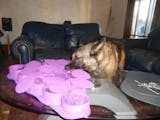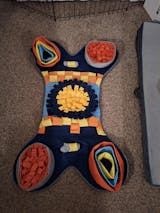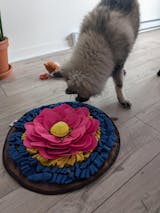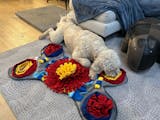Pets grow better when you include consistent rules and structured activities to their routine. An organized schedule decreases stress, prevents negative behavior, and is healthy for learning and growth. Supplementing with enrichment toys and snuffle mats adds another level to this structure by stimulating your dog's innate sense, encouraging puzzle solving ability, as well as providing both mental and physical exercise.
This guide explains the fundamental rules and strategies for dogs and cats, showing examples of how to best use the right food enrichment tools in a meaningful way that will change your pet's life.
Basic Rules and Enrichment Ideas for Dogs
Keeping your fur friend well-behaved includes way more than just basic training. Here are the main rules and enrichment routines for pets:
1. Mental Stimulation and Time Rules for Dogs
A dog's brain needs as much exercise as its body. Understanding time perception and structured stimulation is key.
Rule
Explanation
Example
Tools
3-Second Rule
Give 2-3 seconds to allow your dog to respond to a command before prompting
Ask “sit” and wait 3 sec instead of repeating “sit-sit-sit”.
Dog enrichment mats, mental stimulation toys for dogs
Rule of 7’s
Make sure your puppy follows the Rules of 7’s by the age of 3 months.
Been on 7 surfaces, played with 7 toys, met with 7 people, and more
Puzzle mat for dogs, Doggy mats, dog enrichment toys
3-3-3 Rule
An adopted pet will always take 3 days to decompress, 3 weeks to settle in, and 3 months to feel at home.
Be patient and give them joyful toys and activities to play with
Dog Sniffing Mat, dog enrichment mats
90-10 Rule
90% of your dog's diet must come from well-formulated food while 10% may come from treats.
Spread dry treats on a snuffle mat and other food on a lick mat for better mental enrichment
Snuffle mats, lick mats, Mental stimulation toys for dogs
Time Perception Rule
Dogs perceive time slower
10 min sniffing = ~30–60 min exercise
Enrichment mats for dogs
Tip: Begin with short stints on snuffle mats for dogs and then hide the treats deeper to gradually increase difficulty.
2) Guidelines to Use Snuffle Mats for Dogs?
Many dogs perform their best when they are mentally engaged, and snuffle mats deliver just that. Snuffle mats benefit your fur babies in a variety of ways by providing relief from stress, curious stimuli to investigate, and the satisfaction of a true foraging activity within the confines of our homes.
Further, providing the proper size mat to meet a dog's sniffing needs allows for the most effective benefit - short, supervised sessions stimulate dogs without overwhelming them. Also, make sure it is cleaned after every session. Use a mesh laundry bag for snuffle mats to add a protective layer while washing in a machine.
Dog Size / Type
Recommended Mat
Duration
Tips
Small Dogs
Small Snuffle Mat for Dogs
10 min
Start with visible treats
Large Dogs
Snuffle Mat for Large Dogs
10–15 min
Chewer-resistant material
Heavy Chewers
Best Snuffle Mat for Dogs
5–10 min
Supervise your fur baby to ensure safety.
Other Tips:
Frequency: Short daily sessions are the most effective; avoid overdoing it.
Supervision: Necessary for all kinds of dogs, whether it’s a heavy chewer or a puppy.
Cleaning: Weekly washing in mild, soapy water with a cold water rinse after heavy use and air dry.
Alternatives: Can use other dog enrichment mats, but avoid unsafe substitutes like bath mats.
3. Reward and Training Rules
Rule
Explanation
Tips
Professional Treats
Small, high-value treats reinforce behavior
Chicken, cheese, or specialized dog treats
Interactive Toys
Use dog enrichment mats, puzzle mats for dogs, or Dog Sniffing Mat with training
Rotate toys to maintain novelty
Consistency Rules
Train at the same time daily; repeat commands using the 777 rule
Integrates naturally into a daily routine
4. Additional Dog Enrichment Guidelines
Indoor Boredom Busters: Rotate mental stimulation toys for dogs, tug toys, and enrichment mats for dogs.
Rest Rule: Mental stimulation needs its downtime; not too much stimulation!
Environmental Enrichment: Introduce scents, varied textures, or hidden treats.
Chewing Rule: Supervise for chewing, especially when using mats or puzzle toys.
Golden Rules and Enrichment Ideas for Cats
Happy cats aren’t just born; you grow them with proper play, structure, and stimulation. Here are the golden rules and enrichment activities that keep your feline curious, calm, and thriving.
1. Mental Stimulation Rules for Cats
Rule
Explanation
Example
Tools / Keywords
3-3-3 Rule for Cats
3 toys, 3 types of play, 3 times a day
Wand toy, ball, cat sniffing mat
Cat enrichment, feline enrichment
15-9-4 Rule
15 min active play, 9 min hunting, 4 min rest
Laser pointer + treat hunting
Indoor cat enrichment, feline enrichment toys
Rule 12 – Petting Rule
Short petting sessions to prevent overstimulation
1–2 min strokes per session
Enrichment for cats
25-Rule for Cat Food
Portion control + enrichment
Use puzzle feeders or cat snuffle mat
Feline enrichment, indoor cat enrichment
2. Snuffle Mat & Licking Pad Rules for Cats
Cats & Snuffle Mats: Short, monitored activities keep it from being boring.
Licking Pads: Offer relaxing sensory enrichment when combined with treats.
Rotate Toys: Cats can be entertained with feline enrichment toys or hidden treats.
Observe Cat Behavior: If you see your cat scratching, over-grooming or new excessive meowing, then consider those as signs of under stimulation.
Activity
Duration
Benefits
Tools / Keywords
Hunting Game
10 min
Exercise, mental stimulation
Wand toy, cat sniffing mat
Puzzle Feeder
10–15 min
Slow feeding, problem solving
Feline enrichment toys
Licking Pad
5 min
Calming
Licking pad for dog/cat-safe
Toy Rotation
5–10 min
Prevent boredom
Ball, feather, cat snuffle mat, like the Fishy Affair
3. Additional Cat Guidelines
Nighttime Activity Rule: Schedule enrichment in the evening to reduce 3 am zoomies.
Silent Killer Rule: Stress and boredom impact health; regular stimulation prevents this.
Bonding Rule: Structured play strengthens the human-cat bond.
Advanced Enrichment Strategies for Both Dogs and Cats
To prevent boredom and stimulate pets' mental needs, it is essential to alternate activities and learn about their preferences:
Mix & Match rule: Switch up snuffle mats, puzzle mats, and treat-based games for both dogs and cats to keep your pet entertained.
Enriching: Add a variety of scents, textures, and sounds to stimulate your pet's senses.
Observation & Adjustment: Pay attention to how your pets react to games, and adjust the sequence of games as needed to give them a balanced and happy experience.
Time of Day
Dog Activity
Cat Activity
Tools
Morning
Walk + Puzzle Mat
Laser hunt + Cat Snuffle Mat
Dog enrichment mat, cat sniffing mat
Afternoon
Snuffle Mat session
Rest / Licking pad
Treats
Evening
Tug or fetch + Puzzle
Wand toy + Puzzle feeder
Puzzle mats for dogs, feline enrichment toys
Wrapping it Up
Pets are like kids and you need to make sure that they grow the same way. Mental and physical enrichment does not mean merely the addition of toys. It’s making a moment that will challenge, comfort and bond your pet to you. When you stick to these easy rules and habits, you are not merely controlling behavior, but you are developing trust and confidence, and a happier life in your dog or cat.
FAQ Section
1. How to enrich indoor cat lives on a budget?Easy DIY puzzle feeders, cardboard boxes, snuffle mats, and spinning toys can offer screen-free feline enrichment at low cost.
2. Is licking a good form of enrichment for cats?Lick pad with safe treats provides calming, sensory enrichment that satisfies natural instincts of cats.
3. Why are cats active at 3 am and how can enrichment help?Cats are crepuscular by nature, therefore, evening enrichment sessions with toys or cat sniffing mats will minimize nighttime zoomies.
4. How do I introduce a snuffle mat to my dog?Begin with visible high value treats and short lessons to help your dog learn to forage confidently.
5. What is 15 minutes of mental stimulation for dogs equivalent to?Short duration bursts of sniffing or puzzle play can be equivalent to 30-60 minutes of physical exercise in the amount of energy dogs put out. minutes of physical exercise in terms of energy expenditure.
6. Do vets recommend calming treats for dogs?Yes, vets do recommend natural calming treats to help calm the nerves when faced with stressful situations such as storms or vet visits.












